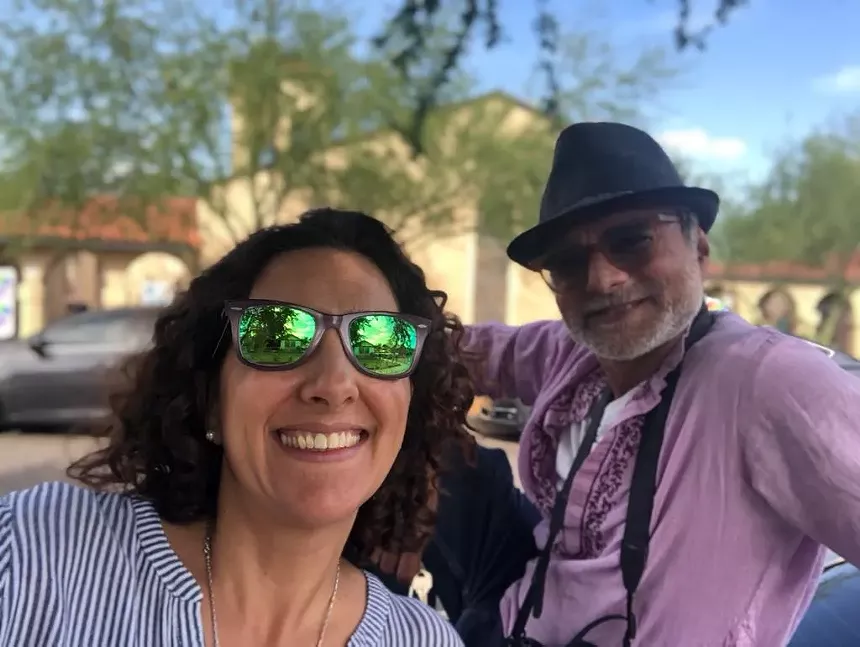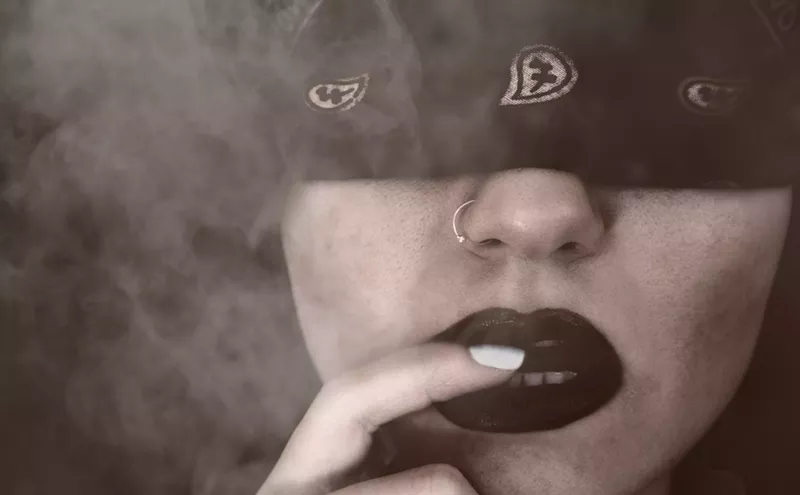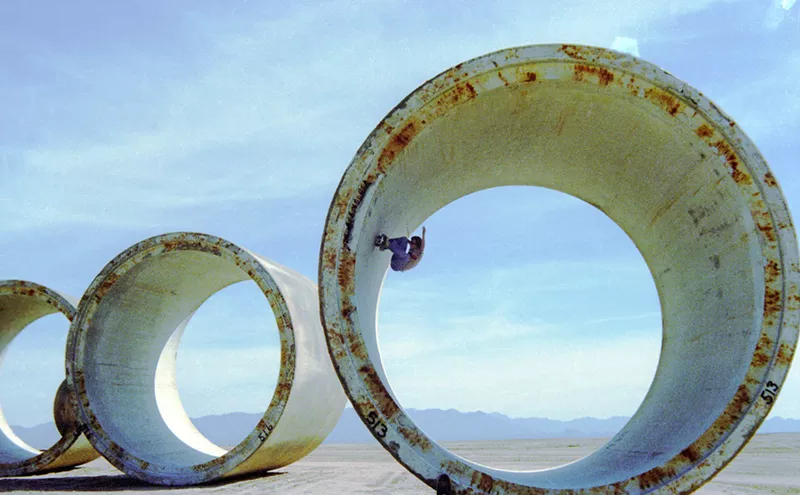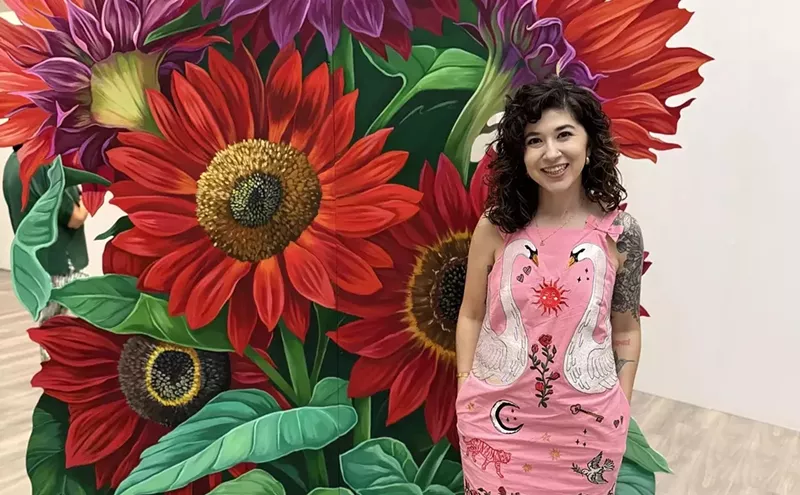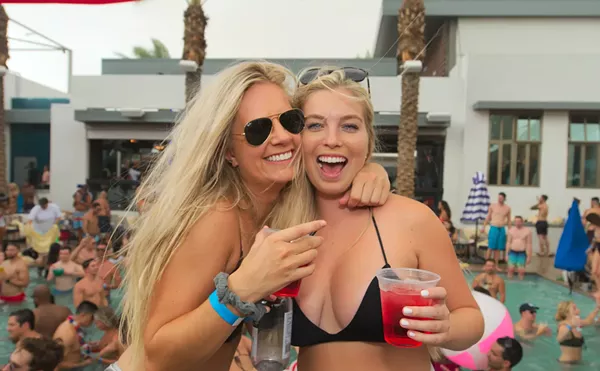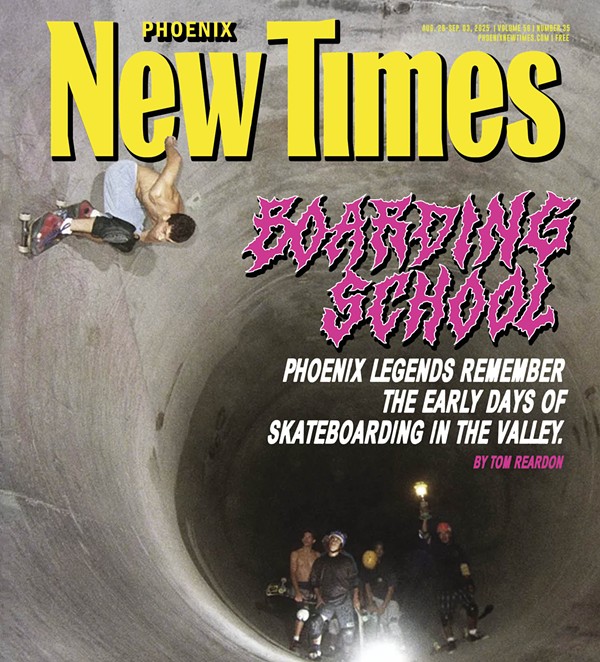Oza is sitting with his elbow on his knee, camera in hand, head tilted. He’s looking down with his impish, knowing smile. Ovalle sees the same warmth with which he once looked at her when they walked the streets of Phoenix documenting stories of Arizona’s migrant and borderlands communities.
With her left hand, she shields her eyes from the intense sun. With her right hand, she’s searching her cellphone for the photo Oza took of her brother the day he was released from prison after a 15-year sentence.
“I will hold that memory in my heart forever,” she says, as a parched wind gently moves her long, wavy hair.
Ovalle is an activist and photographer. She looks at the mural, remembering her friend — a free spirit, always ready at any hour, no matter how long the day had been, to cover stories and meet people.
“Nick was smart, witty and kind,” she says.
Longtime Arizona journalist Valeria Fernández stands with Ovalle, in the thick heat and rush-hour hustle, next to Oza's mural in Phoenix along 19th and Grand avenues.
His image on the towering brick building watches over them. They miss him and feel his spirit here, in the neighborhoods where he cradled the lens of his camera to his eye, ready to turn a fleeting moment into a lasting image.
On Sept. 27, 2021, Oza died from injuries sustained in a car accident earlier that month. He was 57 years old, survived by his wife and daughter.
“He was a very special person in my life, a very dear friend,” says Fernández, founder and director of Altavoz Lab, an organization dedicated to mentoring, training and supporting local journalists. “Also someone from whom I learned a lot.”
Now, Fernández is working with Oza's friends, family and community to ensure his legacy lives beyond newspapers and murals. She’s raising funds for an Altavoz Lab visual fellowship in honor of the beloved photographer, a two-time Pulitzer Prize-winning photojournalist whose images brought life to his work and earned him friends across the world.
The Nick Oza Visual Fellowship is aimed at photographers like Oza, who see the camera not only as a tool, but as a bridge to connect with underrepresented communities. The goal is to support photojournalists who aspire to narrate human complexities with the same art and sensitivity with which Oza explored communities often ignored by major news outlets.
“Nick was a mentor to many other journalists and, although he is no longer with us, through this scholarship we want to continue his legacy and mentorship,” Fernández says. “I know that he would be very happy to know that the work he did will continue to influence future generations.”
A mentor for artists, journalists and photographers
Arizona muralist Lucinda “La Morena” Hinojos always admired Oza's work. Some of her own creations mirrored his photography.“Nick was known for his photojournalism regarding issues like immigration,” she says. “Fascinated by his photojournalism, I often would turn his photos into paintings and murals.”
Hinojos met Oza in 2015 while she was painting a mural in defense of immigrant rights. “Whenever we were in the streets protesting, Nick knew where to find us,” she says.
Oza soon became a trusted friend. “His work inspired me and continues to inspire me,” she says.
Hinojos painted Oza's mural in 2022 as a tribute to his life. For inspiration, she channeled a photo taken by Cecilia García, who came to know Oza when he was documenting the lives of immigrants in his adopted home state. And like so many others who crossed his path, they soon became friends.
“He always showed up unexpectedly at just the right moment,” García says.
García is the founder of the One Hundred Angels Foundation, which provides migrants and other vulnerable communities with medical care and support. Oza was photographing one of the foundation’s service events at a church. García surprised her friend with a rarity — a photo of himself.
“What an honor it is for me that he gave me the opportunity to photograph him and capture him as he really was, an angel among us,” she says.
Hinojos painted Oza in his favorite lavender shirt, sleeves rolled up, wearing his signature fedora hat. His fingers are wrapped around his camera as if he’s ready to snap a quick photo on the sly. Oza was known for surprising friends with images — ones they didn’t even know he’d taken — capturing cherished memories.
On the mural, a dove and a hummingbird are flying near him. Candles flicker. A blooming lotus flower — a symbol of rebirth — commemorates Oza’s roots in Mumbai, India, where he grew up. And images of a border wall alongside him carry the words: Hope, Love, Peace.
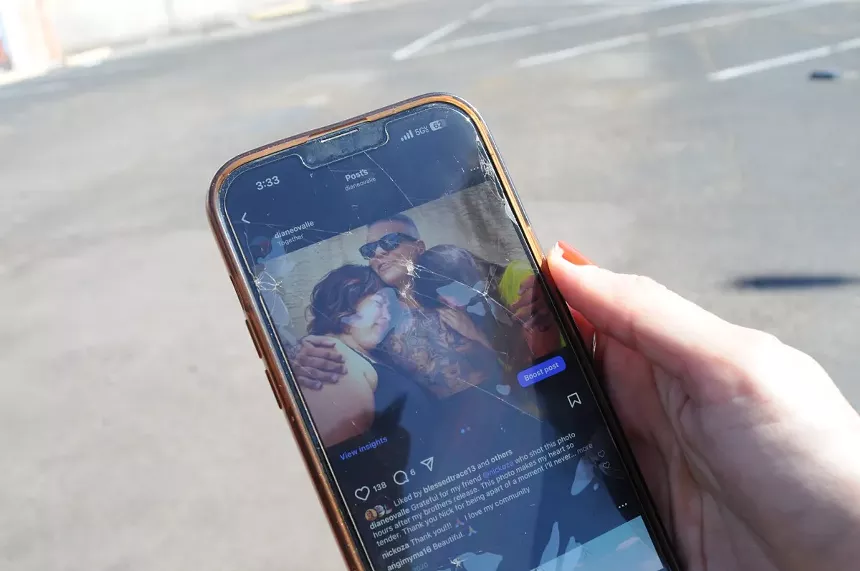
Diane Ovalle holds her cellphone and shows the photo Nick Oza took of her brother the day he was released from prison after a 15-year sentence.
Beatriz Limón
The photographer who ‘was where the people were’
Ovalle remembers the exact moment she met Oza in 2011. She was a young Chicana from West Phoenix marching shoulder-to-shoulder with activists against Senate Bill 1070, a measure known then as the harshest immigration-enforcement law in the nation.“Seeing Nick’s images on the front page of the Arizona Republic made it all feel surreal — it inspired me,” she says. “His work pushed me to go deeper, to tell stories.”
At that time, Ovalle was organizing with the Puente Human Rights Movement. Oza was frequently called upon to cover their protests and press conferences.
“I remember seeing him in the community capturing powerful portraits and telling stories with a deep sense of care and integrity,” she says.
Soon, Ovalle picked up a camera and started taking her own photos documenting history.
She describes Oza as the photographer who “was where the people were.” You could find him at protests, deportation hearings, legal aid fundraisers, in the fields and in churches, she says.
“Nick covered stories about unhoused communities and shed light on people who were forgotten in society,” she says. “Nick was a big advocate for covering immigration policy and deportation.”

On a hot May day, activist Diane Ovalle stopped in front of a mural by photojournalist Nick Oza.
Beatriz Limón
An adventure, working with Oza
For Arizona Luminaria journalist Rafael Carranza, working with Oza always felt like an adventure.When they collaborated at the Arizona Republic, they traveled along the U.S.-México border together, covering stories as difficult as they were necessary.
Oza had “a disarming quality,” he says, that made people feel comfortable in front of his lens.
“That was how he was able to capture authentic moments of joy, sadness and everything in between,” he says.
What Carranza misses most about working with Oza isn’t the big stories or the trips along the border, but the spaces between one assignment and the next, those moments of pause when they could talk or joke unhurriedly.
“He had so much knowledge and lived through so many unique experiences that I felt like I never stopped learning from him,” he says.

Diane Ovalle and Valeria Fernández formed a heart with their hands as the image of Nick Oza rose in the background.
Beatriz Limón
Seeking to document underrepresented communities
That connection that Oza cultivated with underrepresented communities — that ability to capture the essence of a story through images with sensitivity and a touch of art — is precisely what Fernández hopes to find in the photographers who apply for the fellowship.“We want to award the scholarship to a journalist who can do this style of documentary journalism, who can take the time to capture images, spend time with people,” she says.
“These are times when the news never stops,” she adds. That’s why she’s looking for a photographer who, given time — seven months or even a year — can document a story in depth.
“We’re living in a time when journalists have to rush out to cover a number of things,” she said. “We want to give a community journalist, a photographer, the opportunity to take a pause and focus on a project.”
Through local and global donations, she hopes to raise $20,000 to support the national Nick Oza Visual Fellowship. Contributions are tax-deductible and can be made online through May 31.
Fernández envisions the fellowship lasting year after year. “The idea is to continue seeking funding and connect with other organizations specializing in visual journalism so it can stay established,” she says.
Under the late afternoon sun, Ovalle and Fernández walk together closer to the mural. They form a heart with their hands, while the image of Oza, their friend and mentor, watches over them.
Dianna Náñez contributed to this article.
This article first appeared on AZ Luminaria and is republished here under a Creative Commons Attribution-NoDerivatives 4.0 International License.





